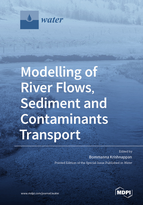Modelling of River Flows, Sediment and Contaminants Transport
A special issue of Water (ISSN 2073-4441). This special issue belongs to the section "Water Erosion and Sediment Transport".
Deadline for manuscript submissions: closed (31 July 2021) | Viewed by 20596
Special Issue Editor
Interests: river dynamics; cohesive sediment transport; environmental hydraulics; mathematical modelling; diffusion and dispersion processes; water quality
Special Issues, Collections and Topics in MDPI journals
Special Issue Information
Dear Colleagues,
Land use activities such as mining, forestry, agriculture, and urban development often result in the production of sediment and contaminants that are transported downstream by rivers and streams in the watershed. A better understanding of the transport capacity of river flows, the interaction between sediment and contaminants, and the behavior of sediment in different flow fields are essential for assessing the environmental impacts of the human activities in the watershed. Tremendous progress has been made in recent years in developing mathematical models of river flows and sediment and contaminant transport; however, more work needs to be done in this area. For example, modelling of morphological changes of river under various flow conditions are not well developed. Cohesive sediment transport processes such as flocculation, consolidation, and entrapment need further research, and the interaction between sediment and contaminants is not fully understood. The Special Issue on modelling river flows, sediment, and contaminant transport aims to gather high-quality papers that improve the state-of-the art. Submitted papers will go through a peer-review process performed by independent reviewers. Original case studies and review papers are invited for this Special Issue.
Dr. Bommanna Krishnappan
Guest Editor
Manuscript Submission Information
Manuscripts should be submitted online at www.mdpi.com by registering and logging in to this website. Once you are registered, click here to go to the submission form. Manuscripts can be submitted until the deadline. All submissions that pass pre-check are peer-reviewed. Accepted papers will be published continuously in the journal (as soon as accepted) and will be listed together on the special issue website. Research articles, review articles as well as short communications are invited. For planned papers, a title and short abstract (about 100 words) can be sent to the Editorial Office for announcement on this website.
Submitted manuscripts should not have been published previously, nor be under consideration for publication elsewhere (except conference proceedings papers). All manuscripts are thoroughly refereed through a single-blind peer-review process. A guide for authors and other relevant information for submission of manuscripts is available on the Instructions for Authors page. Water is an international peer-reviewed open access semimonthly journal published by MDPI.
Please visit the Instructions for Authors page before submitting a manuscript. The Article Processing Charge (APC) for publication in this open access journal is 2600 CHF (Swiss Francs). Submitted papers should be well formatted and use good English. Authors may use MDPI's English editing service prior to publication or during author revisions.
Keywords
- river dynamics
- sediment transport
- contaminant transport
- mathematical modelling
- human impact
- environmental impact assessment
- water quality






